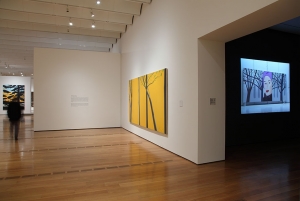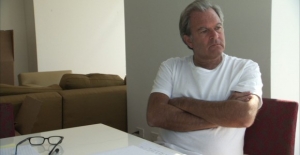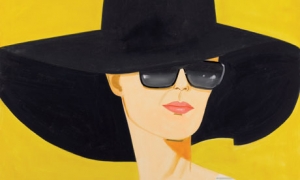|
Displaying items by tag: Alex Katz
The Pollock-Krasner House and Study Center in Springs will present “Elaine de Kooning Portrayed,” a show that will include portraits of the artist both by her hand and those of others beginning next Thursday.
Through her own work as an artist and writer and her long association with her husband, Willem de Kooning, one of the most influential artists of the 20th century, Ms. de Kooning enjoyed many artistic friendships. The evidence can be seen in the show’s various images of her by artists such as Alex Katz, Robert De Niro Sr., Hedda Sterne, Fairfield Porter, and Arshile Gorky.
The early work of artist Alex Katz (b. 1927) is the subject of a major new exhibition at the Colby College Museum of Art, on view from July 11 through October 18, 2015. Brand-New & Terrific: Alex Katz in the 1950s explores the first decade of the artist’s career, a period characterized by fierce experimentation and innovation from which Katz’s signature style emerged. The exhibition is the first museum survey to focus on the artist’s output from this formative decade.
Curated by Diana Tuite, Katz Curator at the Colby Museum, Brand-New & Terrific draws from the Colby Museum’s deep collection of artworks by Alex Katz and will include many rarely seen loans from the artist and other public and private collections.

The High Museum of Art presents a major exhibition of 60 works created between 1954 and 2013 by internationally acclaimed American artist Alex Katz, including 15 monumental landscape paintings to be displayed publicly together for the first time. “Alex Katz, This Is Now” is one of the largest exhibitions focused on the artist’s landscapes in almost 20 years. The High is the sole U.S. venue for the exhibition, which will also tour to the Guggenheim Museum Bilbao.
On view from June 21 to Sept. 6, 2015, the exhibition traces Katz’s unique artistic treatment of the landscape throughout the trajectory of his career, from his 1950s collages that use the environment as a setting for the human figure, to the artist’s later works, which illustrate Katz’s shift to landscape as the dominant subject. Approximately one third of the paintings featured in the exhibition were created by Katz within the last decade, offering visitors an opportunity to view the artist’s contemporary works alongside early examples from his career...
The veteran American artist Alex Katz was inspecting the hang of his new paintings while I looked at them, but I could not ask him any questions. I was dumbstruck. The only thing I could have said to him at that moment would have been a stuttered, “How come you paint so well?”
How can simple pictures of faces be so unexpected, exciting and fascinating? Katz has been painting portraits for a long time now – he’s 87 and began his career in the age of Jackson Pollock – and his latest works do not shatter his established style. Their main novelty is that all the figures are set against black. Many of the pictures have a wide CinemaScope format so the people in them stand out as colourful shapes against a nightscape of glossy darkness.
The Whitney Museum of American Art and The High Line, New York City’s elevated, linear park, have announced a public art collaboration that will launch in July. The long-term project will kick off with the installation of an enlarged digital print of Alex Katz’s painting “Katherine and Elizabeth” (2012) on the North-facing wall of a residential building at the southern end of The High Line. The work has never been shown publicly.
Katz, a celebrated figurative artist, has worked closely with the Whitney for 40 years. The museum hosted a solo show of the artist’s prints in 1974 as well as the first major retrospective of his work in 1986. Katz has also been involved in a number of public art projects, including an installation at New York’s RKO General building in 1977, a commission for Chicago’s transit authority in 1984, and a collaboration with the Art Production Fund in 2010 that involved replacing advertisements atop New York City taxicabs with images of his artwork.

On July 2, 2013, a U.S. District judge decided the fate of 15 contemporary artworks once belonging to the disgraced financier and attorney, Marc S. Dreier. Dreier was convicted of fraud in 2009 for selling hundreds of millions of dollars in fake promissory notes to hedge funders and a section of his collection has remained in limbo ever since.
Judge Jed S. Rakoff ruled that the art holdings, worth $33 million, will be turned over to New York’s Heathfield Capital Limited, the company that suffered the greatest from Dreier’s scam. The works going to Heathfield Capital include a piece by the conceptual artist John Baldessari (b. 1931), an untitled work by Keith Haring (1958-1990), one work by Alex Katz (b. 1927), three by Roy Lichtenstein (1923-1997), an untitled work by Mark Rothko (1903-1970) and three pieces by Andy Warhol (1928-1987) including the iconic Jackie portrait of Jacqueline Kennedy Onassis. The bulk of Dreier’s collection was sold in 2010 at Phillips and the profits were reserved for creditors of Dreier’s law firm.
Drier is currently service a 20-year sentence at a federal prison in Minnesota.
The Nassau Museum of Art in Roslyn Harbor, New York is currently presenting the exhibition Alex Katz: Selections from the Whitney Museum of Art. The solo show consists of an array of large, striking portraits by the American artist Alex Katz (b. 1927). The exhibition is drawn from the Whitney Museum of American Art’s extensive collection of the artist’s work.
A primarily figurative painter, Katz often portrays his friends and family, especially his wife Ada, in simple, brightly colored compositions. Because of these aesthetic predilections, he has often been associated with the Pop Art movement. Katz’s expansive oeuvre also includes numerous landscapes, particularly of New York City and Maine. Since 1951 Katz has been the subject of over 200 solo exhibitions and he has been included in nearly 500 group shows worldwide.
Alex Katz: Selections from the Whitney Museum of Art will be on view at the Nassau Museum of Art through October 13, 2013.

It's a pleasure to look at Alex Katz's paintings, and at the people and places in them; the people can show a restrained kind of pleasure themselves, though they don't often look back at you. Instead they look aloof, sometimes through sunglasses, dressed for summer; we can try to enjoy their company, imagine ourselves moving carefully into the bright shapes and the hard light of their world. Sometimes the people are poets, or else dancers whose poise suggests runway fashion: Katz studied fashion in high school, worked with a dance company for decades, and spent a great deal of time, early in his career, with the exuberantly informal, intellectually playful poets known now as the New York school (John Ashbery, Frank O'Hara, James Schuyler and so on). At other times the people in the paintings turn out to be the same person, Katz's wife of 50-odd years, Ada, depicted with admiration and reserve.
As for those places, they're comfortable, often outdoors: vacation spots, with seashores, piers and pine trees. They might be in Maine, where Katz lives for part of each year, or else they are other holiday spots for the denizens of New York's Upper East Side, a long way from Katz's own childhood as a Russian Jewish immigrant, born in 1927 and raised in Brooklyn and Queens. From there he attended Cooper Union, the famously selective Manhattan art college, and in 1949 the Skowhegan School in Maine: there, Katz has said, he found his vocation in figures and landscapes, attracted to the coastal light.
Katz in the early 1950s had trouble making his way into a gallery scene dominated by heroic abstractions such as those of Jackson Pollock. Rather than change course, he found friends and allies in poets – O'Hara, Schuyler, the dance critic Edwin Denby – and other painters, such as Larry Rivers, who had also returned to figuration. By the end of that decade his reputation was set: he has moved easily among New York writers and galleries ever since. While Katz has tilted back and forth among genres – one year brought a series of head-only portraits of poets, another a seascape – his sense of clean outlines and big colours has remained at the base of his style.
Katz favours bright, uniform planes, put together to make up faces and bodies, with just enough depth to keep up an illusion. Behind the people, and when there are no people, he offers solid lines, flat skies, landscapes that are almost abstractions, as in Matisse: Katz often seems to be thinking about Matisse, or else about other friendly modernist models for his not-quite-realist homage to how the world looks. (Katz's memoir, Invented Symbols, says that "the only art book I had for twenty years" was a collection of pictures by Henri Rousseau.) The people themselves in Katz's paintings can look almost flat too, like people on posters, in four-colour printing, or in old comic books. They are almost cartoons, but not quite: not even the outsized Black Hat (Bettina) (2010), whose subject looks out from a wide hat and black sunglasses with scarlet lips in a slight smile, as if from an old cigarette ad.
There are jokes about flatness, jokes against doctrinaire abstraction, all over Katz's work. In Ada on Red Diamond (1959) the painter's wife and muse emerges enigmatically from a red diamond on a brown square, a background borrowed perhaps from a Russian Suprematist: she's smiling, too, as she gives life to what would otherwise be an empty frame. Red Sails (1958), a collage of coloured paper, could be an abstract experiment with asymmetrical fields of two colours, juniper on tangerine, except for the tiny red triangles in the middle: they're sails, so that orange-red field must be a sea.
Older conventions of representational painting appear, too, and Katz takes them seriously: full-length portraits, head studies and profiles, boating scenes, cloud studies like John Constable's, even an odalisque. Recent landscapes and seascapes invoke East Asian practice, using single brushstrokes to connote harmony as well as immediacy: the whitecaps in Grey Marine (2000) come close to calligraphy. Katz gets compared at times to Pierre Bonnard, for his colours (bright orange! bright green!), and for those portraits of his wife. Whether she's facing out at us, just head and shoulders, or in a bathing suit, the paintings show respect: it looks as if she has chosen to be there. Bonnard also stands behind some of Katz's flowers, whose red-orange and bright-yellow petals curl in close-up views like enormous match flames.
Katz's people and places seem content with the present moment; they are not likely to lose themselves in memories. "The real excitement in art," Katz has written, "is somehow being in the contemporary world." He shared this desire to be absolutely contemporary with his poet friends of four and five decades ago. Katz painted or drew O'Hara several times – "O'Hara is my hero," he once said; there's a fine double portrait with Bill Berkson where both poets appear as uniformed sailors, with come-hither looks – but none of those portraits has made it to St Ives, where the selection concentrates on land- and seascapes, outdoor portraits and pictures of Maine. We do, though, get one full-length portrait of Schuyler, the subtlest and most musical of the New York school poets, slightly lost and lonely in his drab black suit.
Besides easel paintings and prints, Katz became famous during the 1960s for flat, life-sized, painted figures made out of plywood or aluminum, which stand on the floor like genuine people, or sculptures: they are not quite sculpture, but "flat" paintings you can walk all the way around. These works suggest the relative "flatness" of real people's real identities, the way that we fit our acquaintances into types, and the pseudo-acquaintance we have with celebrities: we know about them, but we don't know them for real, we can't know what goes on inside.
|
|
|
|
|